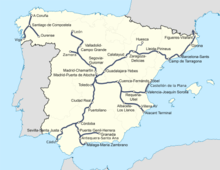Atlantic Axis high-speed rail line
The Atlantic Axis high-speed rail line, also called Atlantic Corridor high-speed rail line, is a high-speed railway line that links A Coruña and Vigo in Spain. The Atlantic Axis was inaugurated in April 2015.
| Atlantic Axis high-speed rail line | |
|---|---|
| Overview | |
| Type | High-speed rail |
| Status | Operational |
| Locale | Spain (Galicia) |
| Termini | A Coruña Vigo-Urzáiz |
| Ridership | 3.6 million (2017)[1] |
| Operation | |
| Opened | 20 April 2015 |
| Owner | Adif |
| Operator(s) | Renfe Operadora |
| Technical | |
| Line length | 155.6 km (96.7 mi) |
| Number of tracks | Double track |
| Track gauge | 1,668 mm (5 ft 5 21⁄32 in) Iberian gauge |
| Electrification | 25 kV 50 Hz |
| Operating speed | 250 km/h |
History
Construction started in 2001 and the first section between A Coruña and Santiago de Compostela opened in 2009 and was electrified in 2011. The extension from Santiago de Compostela to Vigo completed in March 2015[2] and the entire line was inaugurated on 18 April 2015. The total investment of the project exceeded €3bn.[3]
The line was planned to be extended to the south towards the border between Spain and Portugal and with a further connection to the city of Porto including the longest railway bridge on the Iberian Peninsula for the 4.5 km crossing of the Minho River. It was also planned to be extended to the north from A Coruña to Ferrol. However, these plans were shelved in 2011.[3]
Features
The line has a length of 155.6 km of Iberian gauge track of 1,668 mm (5 ft 5 21⁄32 in), which is due to be converted to Standard gauge 1,435 mm (4 ft 8 1⁄2 in) once the Madrid-Ourense-Santiago de Compostela high speed line is fully operational. It is an upgrade of the former 241 km non electrified single railway line between the town of Ferrol and the Portuguese border into a double electrified high-speed line for the part between A Coruña and Vigo. The new rebuilt railway permits mixed use traffic with a maximum design speed of 250 km/h for passenger trains.[4] The new line has 37 tunnels totalling 59.2 km, 38% of the total length and the longest is the 8.25 km tunnel beneath Vigo which connects the line with the new Vigo-Urzaiz station. It also has 32 major bridges, including a 2.4 km viaduct across the valley of the River Sar. The new line shorten the distance between A Coruña and Vigo by 22 km, from 178 km to 156 km, and cut the travel time from around 3 hours on the old railway down to 1 hour and 20 minutes on the new one.[3] The line is linked to the Madrid–Galicia high-speed rail line in Santiago de Compostela, which as of 2019 is under construction.
Ridership
Within two months of opening in June 2015, the line had carried 400,000 passengers.[5] By January 2017 total cumulative ridership was 5.1 million.[6]
| Wikimedia Commons has media related to Atlantic Axis rail line. |
References
- "El tráfico de viajeros en tren crece a ritmo de récord entre Vigo y Coruña". Atlantico Vigo. 8 October 2019. Retrieved 30 August 2019.
- "Fase final de las obras del Eje Atlántico y de la nueva estación de Vigo-Urzáiz". fomento.gob.es. 30 March 2015. Retrieved 23 November 2015.
- Fernando Puente (20 April 2015). "Spain inaugurates Galicia high-speed line". International Railway Journal. Retrieved 20 November 2015.
- "Eje Atlántico". Adif. Retrieved 20 November 2015.
- "El Eje Atlántico de alta velocidad supera los 400.000 pasajeros desde su inauguración". Europa Press (in Spanish). 20 June 2015. Retrieved 30 August 2019.
- "Cinco millones de pasajeros en el Eje Atlántico". Faro de Vigo (in Spanish). 27 January 2017. Retrieved 30 August 2019.
